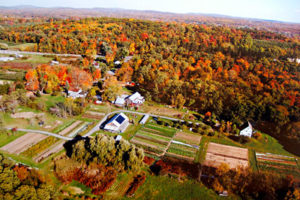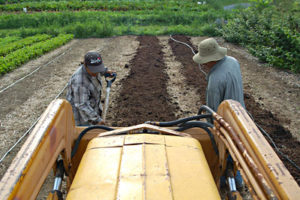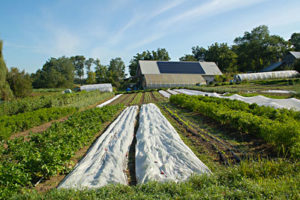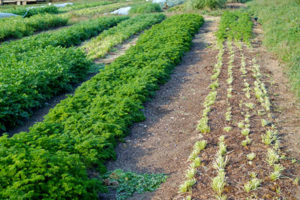 |
| An aerial view of Four Winds Farm in Gardiner, New York. Photos courtesy of Four Winds Farm. |
By Jean English
Jay and Polly Armour of Four Winds Farm in Gardiner, N.Y., practice certified organic no-till vegetable production. They grow crops in permanent beds – some in place for 17 years – that are never plowed or rototilled, so they depend less on energy-consuming tractors and capital-consuming equipment, while fighting fewer weeds.
Their 24-acre Hudson Valley farm supports beef cows, pigs, turkeys and 4 acres of vegetables. Jay advised attendees at MOFGA’s Farmer to Farmer Conference in November 2013 to “start small and slowly expand.”
Soil Preparation and Bed Maintenance
Originally the Armours tilled regularly and added manure – resulting in considerable weed pressure. Lee Reich, author of Weedless Gardening (and other books), convinced Armour that he was making more work for himself than necessary.
Now, after about 18 years of using compost instead of manure and using no-till permanent beds instead of soil-disturbing methods, Armour can plant his land in early spring because he doesn’t have to wait for the soil to be dry enough to plow.
“I’m not tying up capital in expensive tillage and weeding equipment,” says Armour. “By storing carbon in the soil instead of releasing it into the air, I am increasing my organic matter (upward of 6 percent), which reduces water (and soil) runoff, improves moisture retention during drought periods, and makes what weeds I do have easy to pull out.”
 |
| Spreading compost on permanent beds. |
Customers say his vegetables taste better than any others, too.
To transition a lawn or field to garden space, Armour says one can weed whack the plant material down to the ground, then apply sheets of newspaper, then compost, and plant into the compost. Armour told of a N.H. woman who got ends of newspaper rolls and rolled these out instead of using layers of individual newspaper sheets. Beds can also be covered with straw used as mulch the previous year, with compost added on top of the straw in the spring; then planting can be done through the compost.
“To transition a large space, like 1/2 an acre or more,” says Armour, “we recommend first plowing and discing the field, forming the beds, and then covering them with compost or straw right away. From then on with good maintenance, there should be no need to plow again. If the soil has a low amount of organic matter and the weeds get ahead of the grower, then I’d recommend the weed whack-newspaper strategy.”
He originally thought he would let weeds grow in the pathways between permanent beds, but they migrated into his beds, so pathways are now weed-free.
Armour makes all his own compost from manure from the few cows and other animals he keeps and from horse manure from a nearby farm. He mixes it with forks mounted on the front of his tractor. He tries to spread it as soon as it’s ready and he tries to spread as much as possible in the fall. He loads compost into his tractor bucket, and two people fork about four bucket loads per 100-foot bed, or 2 inches in depth, maximum, onto the beds as Armour drives the tractor. He doesn’t put compost on every bed every year; applications depend on the crop to be grown and how much compost he has.
 |
| The Armours’ 4 acres of vegetables are grown using no-till methods. |
He tried a hugelkultur bed last year, making a trench, putting logs, tree branches and blueberry prunings in the bed and covering them with the removed soil and then compost. He planted winter squash there, never watered it, and got much greater yield than from other beds.
For weeding, Armour uses an economical wheel hoe from Nolt’s Produce Supply in Pennsylvania (www.noltsproducesupplies.net/), standing to the side of a bed and using it diagonally.
Comfrey growing on the edge of the garden prevents grass from growing into the beds. The comfrey itself hasn’t become a weed; since the beds are not tilled, no root pieces are spread.
Seeding, Transplanting, Succession Cropping
Rather than cover cropping, Armour uses his vegetable land to grow early greens and then tries to keep all his soil growing something all the time.
To sow seeds, Armour loosens the top of the soil with a scuffle hoe and plants with an Earthway seeder.
After direct sowing onion seeds in early March a couple of years ago and finding that they did as well as greenhouse-grown transplants, he now direct seeds all onions at his zone 6 farm. Last year he sowed in late March and had a “phenomenal crop.” After onions are harvested, he grows a crop of beets.
A pick adze makes a good transplanting tool, said Armour. Issued to soldiers during WW II, they are available now at Army surplus stores. “Chop at the ground to loosen the soil where you want to transplant,” said Armour.
 |
| The weed problem is minimized by minimizing soil disturbance and using compost. |
He grows primarily heirloom and open-pollinated varieties. About 40 kinds of heirloom tomatoes grow on an acre of ground outside, with straw mulch and with plants supported with a basket weave system, with half-inch metal electrical conduit posts between every two plants and a T-post between every eight plants. He sells tomatoes for $4.50 per pound, selling 800 pounds at the height of the season at his Cold Spring farmers’ market. (He also attends farmers’ markets in New Paltz and Woodstock and sells through a CSA.) Last year, ‘TC Jones’ from Baker Creek (a yellow tomato) and ‘Tang’ from High Mowing did surprisingly well, while other varieties suffered from late blight. He burned his tomato crop residue at the end of the season.
Among his succession crops are potatoes harvested in August followed by broccoli raab and spinach and then garlic. In late spring he starts winter squash between garlic rows, and when the garlic comes out, the squash vines are ready to take off.
Peas grow in a single row down the middle of a bed, held up with a basket weave system strung between half-inch metal electrical conduit posts. After removing pea crop residue at the end of the pea season, Armour sows carrots.
Harvest Tips
To cut onion tops after they’ve cured in his barn, one of Armour’s workers attached a hand-scythe blade to a piece of wood so that he could hold the onions and tops with both hands and pull them through the blade.
Armour harvests potatoes with an “ancient potato digger” mounted on his tractor. It gently scoops up and shakes soil back down to the ground, laying potatoes on top of the ground. His soil does not have a lot of rocks. After harvest, he rakes the soil lightly, disturbing it as little as possible so that few weed seeds come to the surface.
Learn more about Four Winds Farm at https://users.bestweb.net/~fourwind/ and https://www.facebook.com/pages/Four-Winds-Farm/58388961551.
